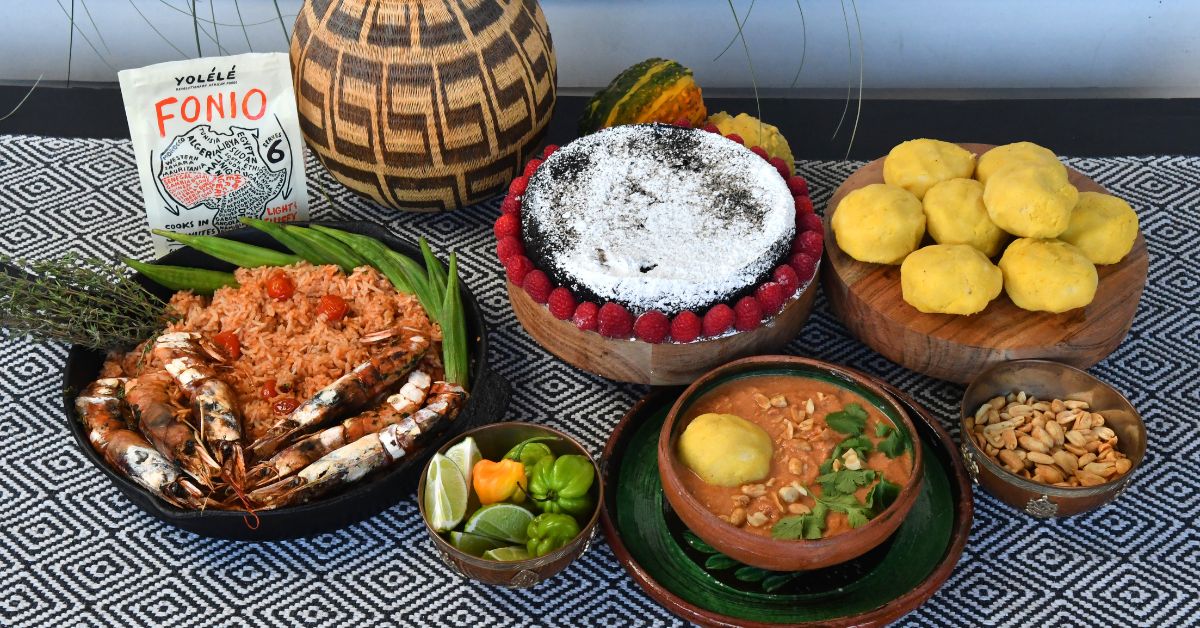Welcome to a culinary journey through the vibrant and flavorful world of West African cuisine! Prepare to tantalize your taste buds as we delve into the rich tapestry of flavors, traditions, and ingredients that make up this diverse culinary landscape. From mouth-watering stews to fiery spices, West African cuisine is a melting pot of influences that will leave you craving for more. Join us as we explore the beauty and diversity of food in West Africa – a true feast for the senses!
West Africa
Nestled on the western edge of the African continent, West Africa is a region teeming with history, culture, and natural beauty. From the ancient empires that once ruled these lands to the bustling modern cities that now define its landscape, West Africa is a fascinating tapestry of past and present.
The diverse environment of West Africa ranges from lush rainforests to sweeping savannas, providing a home to a wide array of flora and fauna. However, deforestation and overfishing have posed significant challenges to this delicate ecosystem in recent years.
Geographically diverse, West Africa experiences a range of climates from tropical in the south to arid in the north. Climate change has also begun to impact the region, leading to unpredictable weather patterns and environmental degradation.
Prehistory
West Africa’s prehistory is a fascinating journey back in time, where ancient civilizations laid the foundation for the region’s rich cultural tapestry. From early hunter-gatherer societies to complex agricultural communities, West Africa has a diverse and storied past that continues to shape its present-day identity.
Archaeological evidence reveals the existence of thriving trade networks and sophisticated metalworking techniques in ancient West African societies. This period marked significant advancements in agriculture, technology, and social organization, laying the groundwork for future empires to flourish across the region.
The rock art found in various parts of West Africa provides glimpses into the spiritual beliefs and daily lives of its early inhabitants. These intricate carvings and paintings offer valuable insights into the artistic expressions of prehistoric communities and their deep connection to nature.
As we delve into West Africa’s prehistory, we uncover a world brimming with innovation, resilience, and creativity – setting the stage for a vibrant cultural legacy that endures to this day.
Empires
The history of West Africa is rich with powerful empires that once dominated the region. These ancient civilizations, such as the Ghana Empire, Mali Empire, and Songhai Empire, were renowned for their wealth and sophistication. They thrived through trade in gold, salt, and other valuable commodities.
The Ghana Empire was one of the first major empires in West Africa. It controlled a vast territory and played a crucial role in trans-Saharan trade routes. The Mali Empire followed suit and became one of the most powerful empires globally under the rule of Mansa Musa.
The Songhai Empire rose to prominence as a center of learning and commerce. These empires left a lasting legacy on West African culture, economy, and politics. Their stories continue to inspire generations to learn about this fascinating period in history.
Environment
West Africa’s environment is a complex tapestry of challenges and beauty. The region has faced issues like deforestation, threatening its rich biodiversity and the livelihoods that depend on it. Overfishing in West African waters poses a risk to marine ecosystems and local fishing communities.
The geography and climate of West Africa are as diverse as the cultures that call this region home. From lush rainforests to arid deserts, each ecosystem plays a crucial role in sustaining life. However, climate change is increasingly putting pressure on these delicate environments, leading to more frequent extreme weather events.
Despite these challenges, West Africa’s natural landscapes remain awe-inspiring. The vibrant colors of its flora and fauna create a visual feast for those lucky enough to witness them firsthand. Protecting the environment of West Africa is not just about preserving its beauty; it’s about safeguarding the future for generations to come.
Deforestation
The issue of deforestation in West Africa is a pressing concern that has significant environmental and social impacts. As forests are cleared for agriculture, logging, and infrastructure development, the rich biodiversity and ecosystem services they provide are being threatened.
Deforestation not only leads to habitat loss for countless plant and animal species but also contributes to soil erosion, water pollution, and climate change. The loss of trees also affects local communities who rely on forests for food, medicine, and livelihoods.
Efforts to combat deforestation in West Africa include reforestation projects, sustainable land management practices, and conservation initiatives. It is essential for governments, NGOs, local communities, and individuals to work together towards preserving the region’s precious forests for future generations.
Overfishing
The issue of overfishing in West Africa is a significant concern that threatens the balance of marine ecosystems. With growing demands for seafood, many coastal communities are facing challenges in sustaining their livelihoods due to depleted fish populations. Overfishing not only impacts the environment but also has socio-economic implications.
Unregulated fishing practices and lack of enforcement of fishing laws contribute to the depletion of fish stocks. This unsustainable exploitation can lead to a decline in biodiversity and disrupt the food chain, affecting not only fish populations but also other marine species dependent on them for survival.
Efforts are being made to address overfishing through sustainable fisheries management strategies and initiatives aimed at promoting responsible fishing practices. Collaborative efforts between governments, local communities, and conservation organizations play a crucial role in ensuring the long-term health of marine resources in West Africa.
Geography and climate
West Africa is blessed with a diverse geography and climate that greatly influences its rich culture and cuisine. The region boasts a variety of landscapes, from the lush rainforests of countries like Ghana to the arid deserts of Mauritania. These contrasting environments have shaped the way people live and eat in West Africa.
The tropical climate in many parts of West Africa supports an abundance of fruits, vegetables, and spices that are essential ingredients in traditional dishes. The warm weather also allows for year-round cultivation of staple crops like cassava, yams, and plantains. On the other hand, countries like Mali experience hot desert climates where nomadic tribes rely on hearty meals made from grains and meats to sustain themselves.
Moreover, the proximity to the coast provides access to fresh seafood which is a significant component of coastal West African cuisines. From spicy grilled fish in Senegal to aromatic stews in Nigeria, seafood plays a vital role in defining regional flavors across West Africa. Overall,…
Climate change
Climate change poses a significant threat to West Africa, impacting the region’s environment and people. Rising temperatures lead to unpredictable weather patterns, affecting agriculture and food security. Droughts and floods become more frequent, disrupting livelihoods and exacerbating poverty.
The coastal areas face the risk of sea-level rise, endangering communities and ecosystems. Extreme weather events like hurricanes are becoming more intense, causing widespread destruction. This changing climate also influences disease patterns, with outbreaks such as malaria spreading into new regions.
West African governments are taking steps to address these challenges through sustainable development practices and adaptation strategies. However, international cooperation is crucial in mitigating the effects of climate change on this diverse and vibrant region.
Culture
Immerse yourself in the rich and vibrant culture of West Africa, where artistry flourishes in every corner. From intricate patterns adorning textiles to captivating traditional architecture, the cultural tapestry of this region is truly awe-inspiring.
Art in West Africa reflects a deep connection to heritage and spirituality, with each piece telling a unique story passed down through generations. Traditional masks, sculptures, and paintings offer a glimpse into the diverse belief systems and rituals that shape daily life.
The architecture of West Africa is equally compelling, blending indigenous building techniques with influences from Arab and European styles. Mud-brick mosques stand tall alongside colorful colonial buildings, showcasing a fusion of past and present.
When it comes to clothing, West Africans express themselves through vibrant fabrics like Ankara and Kente cloth. Each garment tells a story through its colors and symbols, reflecting individual identity within the broader cultural landscape.
Step into the world of West African culture – where creativity knows no bounds!
Art
Art in West Africa is a vibrant and diverse expression of creativity that reflects the rich cultural heritage of the region. From intricate wood carvings to colorful textiles, West African art showcases a deep connection to tradition and storytelling.
Traditional masks and sculptures hold symbolic meanings, often representing spiritual beliefs or ancestral spirits. These artworks are not just decorative but are also used in ceremonies and rituals, adding layers of significance to their aesthetic beauty.
Textiles woven with intricate patterns and bold colors play a significant role in West African art. Each design tells a unique story, reflecting the history and identity of different tribes and communities across the region.
Contemporary artists in West Africa continue to innovate, blending traditional techniques with modern influences to create dynamic pieces that resonate on both local and global scales. The art scene in West Africa is constantly evolving, showcasing the talent and creativity of its people.
Traditional architecture
West Africa is home to a rich tapestry of traditional architecture that reflects the diverse cultures and histories of its people. From the ancient mud-brick mosques of Mali to the colorful painted houses of Burkina Faso, each structure tells a story of craftsmanship and ingenuity.
The unique architecture in West Africa often blends elements of Islamic design with local building techniques, creating stunning structures that are both functional and aesthetically pleasing. The use of natural materials like mud, wood, and thatch not only helps buildings blend harmoniously with their surroundings but also showcases the region’s sustainable building practices.
Traditional architecture in West Africa is not just about physical structures; it encompasses a way of life, community values, and cultural identity. Each building is a testament to the skills passed down through generations, preserving heritage while adapting to modern needs.
Exploring the traditional architecture of West Africa offers insights into how past societies adapted to their environments and celebrated their cultural identities through design. It’s an architectural journey filled with history, artistry, and meaning waiting to be uncovered by those willing to explore off-the-beaten-path destinations in this vibrant region.
Clothing
West African clothing is a vibrant expression of the region’s rich cultural heritage. Traditional garments vary across different countries, showcasing intricate patterns and bold colors that reflect local customs and beliefs. Men often wear flowing robes like the grand boubou or agbada, while women dazzle in elegant wrappers, blouses, and head wraps made from luxurious fabrics.
The craftsmanship behind West African attire is exceptional, with many pieces handcrafted by skilled artisans using traditional techniques passed down through generations. Adorned with elaborate embroidery, beadwork, and dyeing methods such as tie-dye and batik, each garment tells a unique story of identity and pride.
From ceremonial outfits for special occasions to everyday wear that exudes style and grace, West African clothing blends tradition with modern influences to create a fashion statement that resonates globally. Whether it’s the iconic dashiki shirt or the colorful kente cloth from Ghana, these garments celebrate diversity while honoring centuries-old traditions.
Step into the world of West African fashion where creativity knows no bounds!
Cuisine
West African cuisine is a vibrant tapestry of flavors and traditions that reflects the rich cultural heritage of the region. From spicy jollof rice to savory peanut stews, each dish tells a story of history and community.
One key characteristic of West African cuisine is its use of bold spices and aromatic herbs like ginger, garlic, and chili peppers. These ingredients not only add depth to dishes but also showcase the diversity of flavors found across the continent.
Staple foods such as cassava, yams, plantains, and millet are commonly used in West African cooking, providing hearty bases for many traditional meals. Fresh seafood from coastal regions adds a delicious element to dishes like grilled fish with spicy pepper sauce or coconut-infused seafood curries.
Desserts in West Africa often feature tropical fruits like mangoes, bananas, and papayas blended into refreshing treats such as fruit salads or creamy puddings. Whether you’re sampling street food in Lagos or enjoying a home-cooked meal in Accra, exploring West African cuisine is an adventure for the senses.
Recreation and sports
Recreation and sports hold a significant place in the vibrant tapestry of West African culture. From bustling city streets to rural villages, you can witness the passion for various recreational activities and traditional sports that bring communities together.
Football, also known as soccer, is undoubtedly the most popular sport in West Africa. The energy and enthusiasm surrounding football matches are palpable, with local teams competing fiercely and fans cheering passionately from the sidelines.
Traditional wrestling is another beloved pastime that showcases strength, agility, and skill. Communities gather to watch wrestlers engage in competitive bouts full of tradition and cultural significance.
Dancing is not just a form of entertainment but also a way to celebrate history and heritage. Different regions have their unique dance styles that reflect their stories and beliefs through rhythmic movements.
Recreation and sports play an essential role in fostering unity, preserving traditions, and promoting physical well-being throughout West Africa.
Music
West Africa is a region rich in musical traditions that are as diverse as the landscape itself. From the rhythmic beats of the djembe drum to the soulful melodies of traditional kora music, West African music is a vibrant tapestry woven with history and culture.
Music in West Africa plays an integral role in storytelling, community gatherings, and celebrations. It serves as a form of communication, expressing emotions and narratives that have been passed down through generations. Whether it’s the energetic sounds of Afrobeat or the haunting vocals of griot singers, each genre reflects the unique experiences and perspectives of its people.
Instruments like the balafon, talking drum, and shekere are not just tools for creating music but symbols of cultural identity and heritage. The fusion of traditional rhythms with modern influences has led to innovative new genres that continue to captivate audiences worldwide.
The power of West African music lies in its ability to transcend language barriers and unite people through shared experiences. Whether you’re dancing to highlife tunes or swaying to Afro-pop grooves, one thing is certain – music in West Africa will always move your soul.
Religion
Religion plays a significant role in the cultural tapestry of West Africa. The region is known for its religious diversity, with Islam being the dominant faith followed by African traditional religions and Christianity.
Islam has a strong presence in West Africa, influencing various aspects of society from daily rituals to governance. Many West Africans practice a form of Islam that incorporates local traditions and beliefs, creating a unique blend of spirituality.
Traditional African religions are deeply rooted in the history and customs of the indigenous peoples. These belief systems often revolve around nature, ancestors, and spirits, shaping communal practices and ceremonies.
Christianity also holds sway in certain parts of West Africa, introduced through colonialism but evolving into distinct forms infused with local cultures. Churches play a vital role as centers for community gatherings and social support networks.
The religious landscape of West Africa reflects a rich tapestry woven with threads of tradition, spirituality, and adaptation to modern influences.
Islam
West Africa has a rich cultural tapestry woven with various religious beliefs, including Islam. Introduced to the region through trans-Saharan trade routes, Islam has deeply influenced the social fabric of West African societies.
Islamic traditions and practices have become intertwined with local customs, creating a unique blend of spiritual expression. From Senegal to Nigeria, mosques stand as architectural marvels that showcase the beauty and diversity of Islamic art and design.
The call to prayer echoes through bustling marketplaces and quiet villages alike, reminding believers of their faith’s importance in their daily lives. Fasting during Ramadan is not just an individual observance but a communal experience that fosters unity among Muslims in West Africa.
Islamic scholars and teachers play a significant role in preserving knowledge and passing down centuries-old wisdom to future generations. The teachings of Islam continue to shape moral values and guide personal conduct across the region, reflecting its enduring impact on West African culture.
African traditional
Dive into the rich tapestry of African traditions, where customs and beliefs intertwine to create a vibrant cultural mosaic. From intricate tribal ceremonies to age-old rituals passed down through generations, Africa’s traditional practices are steeped in history and significance.
Each ethnic group across West Africa holds its unique set of traditions, from storytelling around bonfires to elaborate rites of passage marking important life milestones. The artistry and symbolism behind traditional dances and music serve as a way to connect with ancestors and honor the spirits that guide daily life.
Traditional attire in West Africa reflects a blend of heritage and modern influences, showcasing bold patterns, vivid colors, and meticulous craftsmanship. Whether it’s the Kente cloth of Ghana or the flowing robes worn by Fulani women in Nigeria, clothing serves as a visual expression of cultural identity.
Intriguing superstitions, folklore tales, and spiritual practices further add depth to African traditional beliefs. Through oral histories preserved by griots or sacred shrines dedicated to deities, these ancient customs continue to shape contemporary society in profound ways.
Christianity
Christianity holds a significant place in the cultural landscape of West Africa. Introduced by European missionaries during the colonial era, Christianity has become deeply intertwined with traditional beliefs and practices in many communities across the region.
The spread of Christianity in West Africa has led to a rich tapestry of religious expression, blending elements of African spirituality with Christian rituals and symbolism. Churches play a central role in community life, serving as places of worship, education, and social gathering.
Throughout history, Christian churches have been instrumental in advocating for social justice and human rights in West Africa. They have also contributed to the development of healthcare and educational infrastructure in many regions.
Today, Christianity continues to evolve and adapt to the changing dynamics of West African society. Despite its complex history, it remains a source of strength and inspiration for millions of people across the region.
Economic and regional organizations
Economic and regional organizations play a significant role in shaping the landscape of West Africa. The Economic Community of West African States (ECOWAS) fosters economic cooperation among member countries, promoting trade and development initiatives across the region. With a focus on integration and stability, ECOWAS strives to enhance the economic well-being of its members through collaborative efforts.
Another key organization is the West African Monetary Union (WAMU), which aims to promote monetary stability and facilitate economic convergence among its member states. By coordinating monetary policies and fostering financial cooperation, WAMU contributes to sustainable growth and prosperity within West Africa.
These organizations provide a platform for dialogue, collaboration, and decision-making that are essential for driving progress in the region’s economy. Through strategic partnerships and joint initiatives, they work towards creating a more unified and prosperous West Africa.
Economic Community of West Africa
The Economic Community of West African States (ECOWAS) is a regional economic union established in 1975. It aims to promote economic integration and cooperation among its member states in West Africa. With 15 member countries, ECOWAS works towards fostering trade relations, facilitating movement of goods and people, and enhancing economic development in the region.
One of the key objectives of ECOWAS is to create a single market where goods, services, and capital can move freely across borders within West Africa. This initiative aims to boost intra-regional trade and strengthen the economies of member states through collaboration and mutual support.
Additionally, ECOWAS plays a crucial role in addressing common challenges faced by West African countries such as security threats, political instability, and social issues. By working together under the umbrella of ECOWAS, member states strive for peace, stability, and sustainable development in the region.
ECOWAS serves as a platform for collective action towards achieving shared goals that benefit all countries involved.
West African Monetary Union
The West African Monetary Union, known as the UEMOA in French, is a regional organization that aims to promote economic integration among its member states in West Africa. Established in 1994, the union consists of eight countries sharing a common currency called the CFA franc.
One of the primary goals of the West African Monetary Union is to foster economic stability and sustainable development within the region. By coordinating monetary policies and facilitating trade among members, the union seeks to enhance financial cooperation and boost economic growth.
Through initiatives such as harmonizing banking regulations and promoting free movement of capital, the UEMOA strives to create a more conducive environment for investment and business activities across member states. Additionally, efforts are made to strengthen financial institutions and improve fiscal governance to ensure long-term economic prosperity for all involved.
The West African Monetary Union plays a crucial role in fostering economic collaboration and driving progress within West Africa’s diverse landscape.
Cuisine in West Africa: West African Cuisine
West Africa boasts a rich and diverse culinary scene that reflects the region’s vibrant cultures and traditions. The West African Cuisine is characterized by bold flavors, aromatic spices, and fresh ingredients sourced locally. Each country within the region offers its own unique twist on traditional dishes, creating a mouth-watering tapestry of culinary delights.
One staple in West African cuisine is jollof rice, a flavorful dish made with rice cooked in a tomato-based sauce with various spices and proteins like chicken or fish. Another popular dish is fufu, a starchy side typically made from cassava or plantains pounded into a smooth consistency served alongside rich soups or stews.
For those with a sweet tooth, desserts like bissap (hibiscus flower drink) or kelewele (spicy fried plantains) offer a perfect balance of sweetness and spice. Whether you’re sampling street food from bustling markets or dining at upscale restaurants, exploring the diverse flavors of West African cuisine is truly an adventure for your taste buds.
West African Clothing
Exploring the vibrant and colorful world of West African clothing is like stepping into a cultural kaleidoscope. The traditional attire in this region reflects the rich diversity and history of each community, with unique fabrics, patterns, and designs that tell stories passed down through generations.
Men’s African clothing often includes garments like dashikis, boubous, agbadas, and kufis. These garments are not just pieces of fabric; they are symbols of identity, status, and heritage. Each stitch carries meaning and tradition woven into every thread.
Women’s African clothing is equally captivating with intricate head wraps, colorful wrappers or iro ati buba ensembles, as well as elegant kaftans. The attention to detail in these outfits showcases the skillful craftsmanship of local artisans who have mastered the art of textile design.
From bold Ankara prints to delicate Kente cloth weaves, West African fashion celebrates individuality while honoring shared cultural roots. Whether worn for special occasions or daily wear, these garments embody a sense of pride and belonging that transcends borders.
Men’s African Clothing
When it comes to men’s African clothing, the styles are as diverse and vibrant as the cultures of West Africa itself. Traditional attire for men often includes grand boubou robes or dashikis made from colorful fabrics that reflect the rich heritage of the region.
These garments are not only worn for special occasions but also serve as a symbol of cultural identity and pride. The intricate patterns and designs on the fabric tell stories of history, traditions, and values passed down through generations.
Men’s clothing in West Africa can vary depending on the specific country or ethnic group. From embroidered tunics to tailored suits with traditional motifs, each piece carries its unique significance and beauty.
Accessories like kufi hats, agbada robes, and fila caps add an extra touch of elegance to men’s outfits in West Africa. Whether dressing up for a celebration or simply embracing everyday style, African clothing for men is a true showcase of craftsmanship and tradition.
Women’s African Clothing
Women’s African clothing is a vibrant reflection of the rich cultural heritage and diversity found in West Africa. From bold patterns to intricate designs, traditional attire for women varies across different regions, showcasing unique craftsmanship and style.
One iconic piece of women’s clothing is the Ankara fabric, often used to create beautiful dresses, skirts, and headwraps. The bright colors and dynamic prints make these outfits stand out at any occasion.
In some cultures, women wear boubous or kaftans – loose-fitting garments that exude elegance and grace. These flowing robes are not only stylish but also comfortable for everyday wear or special events.
Accessories play a significant role in completing an African woman’s outfit. Beaded jewelry, colorful beads, and handwoven baskets add flair to their ensemble while celebrating traditional craftsmanship.
Whether it’s a formal event or a casual gathering, women’s African clothing embodies tradition with a modern twist, making it both fashionable and culturally significant.
Conclusion: West African Cuisine
As we have explored the rich tapestry of West African culture, from its vibrant cuisine to its captivating music and traditions, it is evident that this region holds a unique and diverse heritage. The beauty of West Africa lies not only in its landscapes but also in the warmth and hospitality of its people. From the savory flavors of West African Cuisine jollof rice to the rhythmic beats of Afrobeat music, there is so much to discover and appreciate.
Whether you are indulging in a delectable plate of fufu or admiring the intricate designs of African clothing, West Africa offers a sensory experience like no other. With a history marked by powerful empires and dynamic cultural influences, this region continues to be a source of inspiration for many around the world.
So next time you embark on a culinary adventure or simply want to immerse yourself in the richness of African culture, consider exploring all that West African Cuisine has to offer. Let your taste buds savor the flavors, let your ears dance to the music, and let your heart embrace the beauty and diversity that make West Africa truly special.










